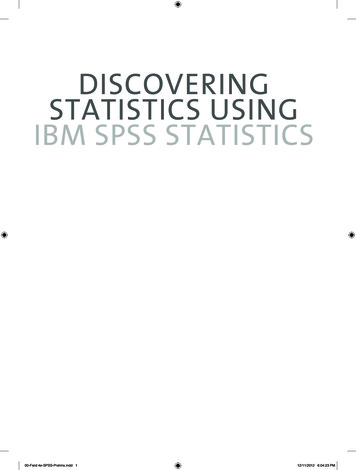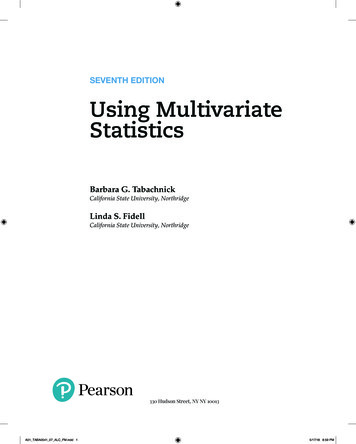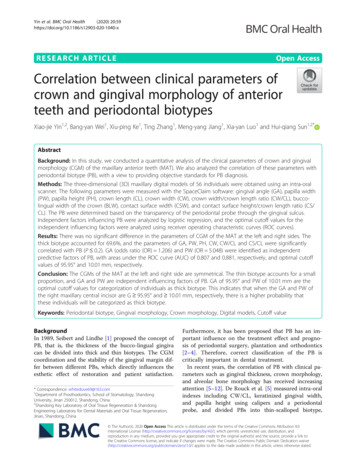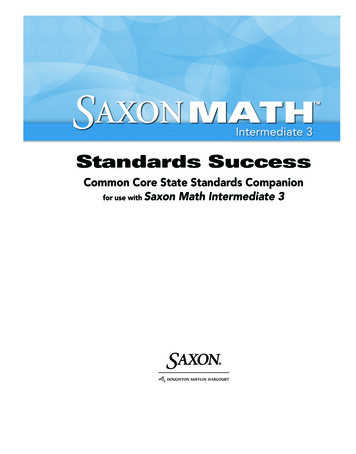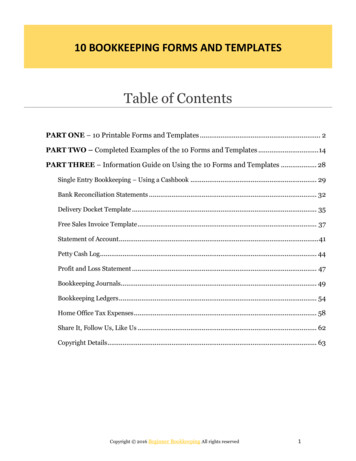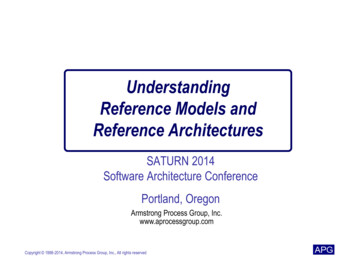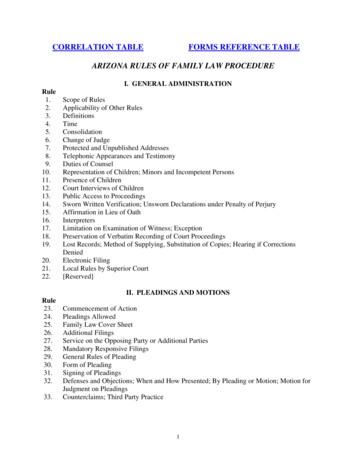
Transcription
CORRELATION TABLEFORMS REFERENCE TABLEARIZONA RULES OF FAMILY LAW PROCEDUREI. GENERAL ADMINISTRATIONRule1.Scope of Rules2.Applicability of Other Rules3.Definitions4.Time5.Consolidation6.Change of Judge7.Protected and Unpublished Addresses8.Telephonic Appearances and Testimony9.Duties of Counsel10.Representation of Children; Minors and Incompetent Persons11.Presence of Children12.Court Interviews of Children13.Public Access to Proceedings14.Sworn Written Verification; Unsworn Declarations under Penalty of Perjury15.Affirmation in Lieu of Oath16.Interpreters17.Limitation on Examination of Witness; Exception18.Preservation of Verbatim Recording of Court Proceedings19.Lost Records; Method of Supplying, Substitution of Copies; Hearing if CorrectionsDenied20.Electronic Filing21.Local Rules by Superior Court22.[Reserved]II. PLEADINGS AND cement of ActionPleadings AllowedFamily Law Cover SheetAdditional FilingsService on the Opposing Party or Additional PartiesMandatory Responsive FilingsGeneral Rules of PleadingForm of PleadingSigning of PleadingsDefenses and Objections; When and How Presented; By Pleading or Motion; Motion forJudgment on PleadingsCounterclaims; Third Party Practice1
34.35.Amended and Supplemental PleadingsFamily Law Motion PracticeIII. PARTIESRule36.Real Party in Interest37.Substitution of Parties38.Process on Behalf of and Against Persons Not Parties39.Proof of Authority by Attorney for Defendant Not Personally ServedIV. SERVICE OF PROCESSRule40.Process41.Service of Process within Arizona42.Service of Process Outside of State43.Service and Filing of Pleadings and Other Papers; Sensitive Data FormV. DEFAULT DECREE, CONSENT DECREE, AND DISMISSALRule44.45.46.Default DecreeConsent Decree, Order or Judgment Without HearingDismissalVI. TEMPORARY ORDERSRule47.48.Temporary OrdersTemporary Orders Without NoticeVII. DISCLOSURE AND DISCOVERYRule49.Disclosure50.Complex Case Disclosure51.Discovery52.Subpoena53.Protective Orders Regarding Discovery Requests54.Depositions before Action or Pending Appeal55.Persons before Whom Depositions May Be Taken56.Stipulations Regarding Discovery Procedure57.Depositions upon Oral Examination58.Depositions upon Written Questions59.Use of Depositions in Court Proceedings60. Interrogatories to Parties61.Uniform and Non-Uniform Interrogatories; Limitations; Procedure62.Production of Documents and Things and Entry upon Land for Inspection and OtherPurposes63.Physical, Mental, and Vocational Evaluations of Persons64.Requests for Admission2
65.Failure to Make Disclosure or Discovery; SanctionsVIII. SETTLEMENT AND ALTERNATIVE DISPUTE RESOLUTION (ADR)Rule66.Alternative Dispute Resolution; Purpose, Definitions, Initiation, and Duty67.Mediation, Arbitration, Settlement Conferences, and Other Dispute Resolution ProcessesOutside of Conciliation Court Services68.Conciliation Court Services; Counseling, Mandatory Mediation, Assessment orEvaluation and Other Services69.Binding Agreements70.Settlement71. Sanctions and Attorneys’ Fees72.Family Law Master73.Family Law Conference Officer74.Parenting Coordinator75.Plan for Expedited ProcessIX. PRETRIAL AND TRIAL PROCEDURESRule76.77.Pretrial ProceduresTrial ProceduresX. JUDGMENTS AND DECREESRule78.Judgments; Costs; Attorneys’ Fees79.Summary Judgment80.Declaratory Judgments81.Entry of Judgment82.Findings by the Court; Judgment on Partial Findings83.Motion for New Trial84.Motion to Alter or Amend a Judgment or Decree85.Motion to Correct Mistakes; Relief from a Judgment or Decree86.Harmless Error87.Stay of Proceedings88.Disability of a Judge89.Judgment for Specific Acts; Vesting Title90.Process on Behalf of and Against Persons Not PartiesXI. POST-DECREE/POST-JUDGMENT PROCEEDINGSRule91.Post-Decree and Post-Judgment ProceedingsXII. CIVIL CONTEMPT AND ARREST WARRANTSRule92.93.94.Civil Contempt and Sanctions for Non-Compliance with a Court OrderSeizure of Person or PropertyCivil and Child Support Arrest Warrants3
XIII. OTHER FAMILY LAW SERVICES AND RESOURCESRule95. Other Family Law Services and Resources96. [Reserved]XIV. FAMILY LAW FORMSRule97.Family Law Forms4
I. GENERAL ADMINISTRATIONRule 1. Scope of RulesThese rules govern the procedure in the Superior Court of Arizona in all family law cases,including paternity, and all other matters, arising out of Title 25, Arizona Revised Statutes(A.R.S.) and, where ordered by the presiding judge of a county or the presiding judge’s designee,Orders of Protection, Injunctions Against Harassment and all proceedings, judgments or decreesrelated to the establishment, modification or enforcement of such orders, including contempt.These rules should be construed and enforced in a manner to secure the just, prompt andinexpensive determination of every action and proceeding.COMMITTEE COMMENTThis rule is based on Rule 1, Arizona Rules of Civil Procedure. Wherever the language inthese rules is substantially the same as the language in other statewide rules, the case lawinterpreting that language will apply to these rules.Rule 2. Applicability of Other RulesA. Applicability of Arizona Rules of Civil Procedure. The Arizona Rules of CivilProcedure apply only when incorporated by reference in these rules.B. Applicability of Arizona Rules of Evidence1. Upon notice to the court filed by any party at least forty-five (45) days prior tohearing or trial, or such other date as may be established by the court, any party mayrequire strict compliance with all or part of the Arizona Rules of Evidence. If a hearingor trial is set upon less than sixty (60) days prior notice, the notice provided for in thisparagraph will be deemed timely if filed within a reasonable time after the partyreceives notice of the hearing or trial date.2. If no such notice is filed, all relevant evidence is admissible, provided, however,that the court shall exclude evidence if its probative value is outweighed by the dangerof unfair prejudice, confusion of the issues, or by considerations of undue delay, wasteof time, needless presentation of cumulative evidence, lack of reliability or failure toadequately and timely disclose same.3. The foregoing notwithstanding, records of regularly conducted activity asdefined in Rule 803(6), Arizona Rules of Evidence, may be admitted into evidencewithout testimony of a custodian or other qualified witness as to its authenticity if suchdocument (a) appears complete and accurate on its face, (b) appears to be relevant andreliable, and (c) is seasonably disclosed and copies are provided at time of disclosure toall other parties.4. Any report, document, or standardized form required to be submitted to the courtfor the current hearing or trial may be considered as evidence if either filed with thecourt or admitted into evidence by the court.5
C. Applicability of Local Rules. To the extent these rules are inconsistent with local rules,the provisions of these rules shall apply.COMMITTEE COMMENTRule 2(B)(4) allows the court to consider as evidence at any stage of the proceedings anyreport or document ordered or required by the court to be submitted to the court. This allowsthe court to consider drug testing results and reports from court-appointed attorneys, guardiansad litem, custody or parenting time evaluators, conciliation services, family law masters,Parenting Coordinators, and other court-appointed experts. The evidentiary value is limited tothe particular trial, hearing or conference for which it is prepared and filed.Rule 3. DefinitionsA. Parties. Reference to a party to the action may include the state.B. Definitions. In these rules, unless the context otherwise requires, the followingdefinitions shall apply:1. In camera. If the court orders that a document be reviewed in camera, the partywho possesses the document shall submit the document ex parte to the court. The courtshall then privately review the document to determine whether it should be furtherdisclosed under applicable law and rules.2. Motion. A motion is a written request made after a petition seeking relief is filed.3. Moving Party. The party (movant or applicant) who has filed a written requestfor relief, regardless of whether or not that party was the petitioner or respondent in theinitial petition.4. Petition. A petition is the initial pleading that commences a family law case orthe initial pleading that commences a post-decree matter. All initial documents shall bedenominated as a petition followed by brief descriptive wording summarizing the natureof the relief sought.5. Petitioner. A petitioner is a person or entity who files the first petition, and shallbe referred to as such in all subsequent documents, including all post-decree petitions,motions and documents in the same case.6. Respondent. A respondent is any opposing party other than the petitioner.7. Response. A response is a document that substantially responds to a petition or amotion, and includes an answer to a petition.8. Sealing. If the court orders that a paper or electronic record or portion of arecord is to be sealed, the record or portion of the record shall be sealed by the Clerk ofthe Court, and the record or portion of the record shall be accessible or disclosed only tothose persons designated by order of the court. This definition is not intended to affectthe substantive rights of any party.6
9. Title IV-D. Title IV-D means Title IV-D of the Social Security Act, 42 U.S.C.651 et seq. Title IV-D is administered in Arizona by the Division of Child SupportEnforcement (DCSE) of the Department of Economic Security.10. Witness. A witness is a person whose declaration under oath or affirmation isreceived as evidence for any purpose, whether such declaration is made on oralexamination, by deposition or by affidavit.COMMITTEE COMMENTThe definition of “witness” in subdivision B(10) is based on Rule 43(a), Arizona Rules ofCivil Procedure.Rule 4. TimeA. Computation. In computing any period of time prescribed or allowed by these rules, byany local rules, by order of court, or by any applicable statute, the day of the act, event or defaultfrom which the designated period of time begins to run shall not be included. When the period oftime prescribed or allowed, exclusive of any additional time allowed under paragraph D, is lessthan eleven (11) days, intermediate Saturdays, Sundays and legal holidays shall not be includedin the computation. When that period of time is eleven (11) days or more, intermediateSaturdays, Sundays and legal holidays shall be included in the computation. The last day of theperiod so computed shall be included, unless it is a Saturday, a Sunday or a legal holiday, inwhich event the period runs until the end of the next day which is not a Saturday, a Sunday or alegal holiday.B. Enlargement. When by these rules or by a notice given thereunder or by order of courtan act is required or allowed to be done at or within a specified time, the court for cause shownmay at any time in its discretion (1) with or without motion or notice order the period enlarged ifrequest therefor is made before the expiration of the period originally prescribed or as extendedby a previous order or (2) upon motion made after the expiration of the specified period permitthe act to be done where the failure to act was the result of excusable neglect; but it may notextend the time for taking any action under Rules 83(D), 84, and 85(C), except to the extent andunder the conditions stated in them, unless the court finds (1) that a party entitled to notice of theentry of judgment or order did not receive such notice from the clerk or any party within 21 daysof its entry, and (2) that no party would be prejudiced, in which case the court may, upon motionfiled within thirty days after the expiration of the period originally prescribed or within 7 days ofreceipt of such notice, whichever is earlier, extend the time for taking such action for a period of10 days from the date of entry of the order extending the time for taking such action.C. Orders to Appear. A judge of the superior court, upon request or petition supported byaffidavit showing cause therefor, may issue an order requiring a party to appear and may makethe order returnable at such time as the judge designates. Any such order to appear shall beserved in accordance with the requirements of Rule 40, 41, or 42, as applicable, of these rules or,if the party to whom the order is directed has entered an appearance in the action, in accordancewith the requirements of Rule 43, within such time as the judge shall direct.7
D. Additional Time after Service by Mail. Whenever a party has the right or is required todo some act within a prescribed period after the service of a notice or other paper upon the partyand the notice or paper is served by mail, five (5) calendar days shall be added to the prescribedperiod. This rule has no application to the mailing of notice of entry of judgment required byRule 81(D).COMMITTEE COMMENTThis rule is based on Rule 6, Arizona Rules of Civil Procedure.Rule 5. ConsolidationA. Scope of Consolidation. When actions within the scope of these rules involving acommon child, common parties, or a common question of law or fact, are pending before thecourt, the court may order a joint hearing or trial of any or all the matters in issue in the actionsor order all the actions consolidated, and the court may make such orders concerningproceedings therein to avoid unnecessary costs or delay or to serve in the best interest of a minorchild.B. Lowest Case Number. Unless otherwise ordered by the court, when two or more casesare consolidated, the clerk of the court shall regard the number of the case filed first as thecontrolling number of the consolidated cases, and all further pleadings and papers shall be filedand docketed under that number only. Unless the court shall otherwise specify, it will bepresumed that the consolidation is for all purposes, and not merely for the purpose of trial.Unless the court shall otherwise order, motions to consolidate shall be heard by the judge towhom the earliest-filed case is assigned. A case involving only an order of protection may beconsolidated into the substantive family law case.C. Duplicate Petitions. When two or more cases are consolidated by court order whereinthe parties have previously filed competing or duplicate petitions that substantially respond to theissues in the opposing petition by stating detailed allegations, requests, or positions on the issues,such petitions shall also serve in all respects as responses to the opposing petitions, unless thecourt, on motion of any party or its own motion, orders further response.COMMITTEE COMMENTThis rule is based on Rules 42(a) and 65(a), Arizona Rules of Civil Procedure.Rule 6. Change of JudgeAll notices and requests for change of judge shall be made in accordance with Rule 42(f),Arizona Rules of Civil Procedure.Rule 7. Protected and Unpublished AddressesA. When Filing an Initial or Post-judgment Petition or Motion. Any person filing aninitial or post-judgment petition, motion or response, whose address is not known to the other8
party and who reasonably believes that physical or emotional harm may result to the person or aminor child if the person’s address is not protected from disclosure, may request the court todesignate that party’s address as protected by:1. filing the substantive petition, motion or response thereto with no addressincluded on it; and2. filing a written request using the Request for Protected Address Form, Rule 97,Form 15; and3. lodging a proposed form of order with the court, ordering that the address beprotected, except that if there is a valid Order of Protection and the clerk can verify theexistence of the Order of Protection, address confidentiality shall be automatic uponfiling a written request as required by subdivision A(2) above; and4. filing the party’s address on a separate sheet of paper for court use.If the court orders that the address shall be protected, the clerk of the court shall thereafterprotect the person’s address from public disclosure until the court orders otherwise. A personwhose address is protected from disclosure under this rule may be served with all subsequentlyfiled documents, by regular first-class mail at the address provided to the clerk in the mannerprovided in this rule. If the court does not order that the party’s address is protected, allsubsequent filings must include the party’s address.B. Court Action.1. Within five (5) days of the filing of a request for an address to be protected, thecourt shall rule on the request, ex parte, without a hearing, unless the court finds itappropriate to set the request for hearing. If the court sets the request for hearing, allparties who have appeared shall be notified of the hearing, and the hearing shall be heldwithin twenty (20) days of the filing of the request.2. At any time during the proceedings, the court may order that any protectedaddress no longer be protected upon request of the party whose address is protected orafter a hearing and upon a finding that there is no reasonable belief that physical oremotional harm may result to the person with the protected address or to a minor child.C. When Serving a Response or Document upon a Party with a Protected Address.Any person required under these rules to serve a response or other document upon a personwhose address is ordered protected from disclosure under this rule may serve the same bydelivering true and correct copies of the documents to be served, together with the proper feeestablished by administrative order to cover the cost of service, to the clerk of the court. Theclerk shall promptly mail the documents by regular first-class mail to the most recent protectedaddress provided to the clerk, and service shall be deemed complete upon mailing. The clerkshall promptly file a written statement verifying the documents that were mailed and the date ofmailing to the protected address signed by the clerk or deputy clerk who mailed the documents.All documents mailed to a protected address shall bear the clerk’s return address, and a notationof any process returned as undelivered shall be made in the court file.9
D. Continuing Duty to Provide the Clerk with Current Address. Any person whoseaddress is ordered protected from disclosure under this rule shall have a continuing duty toprovide the clerk of the court with a current and correct mailing address where the person can beserved with process until one of the following events occur:1. the person whose address is ordered protected files a written notice of publishedaddress in the court file, containing both the person’s current mailing addresses wherefuture service can be accomplished under these rules, and the person mails a copy of thenotice by regular first-class mail to the last address of all persons who have previouslyappeared in the action; or2. the initial or post-judgment petition or motion has been fully adjudicated by theentry of a final appealable order, judgment or decree, and the time to appeal such order,judgment or decree has expired such that personal service is again required forsubsequent petitions under Rule 43(C)(2), as appropriate.E. Protecting the Address in a Title IV-D Case. Nothing in this rule is intended to changethe practice of protecting the address of a parent seeking services in a Title IV-D case as requiredby federal law.COMMITTEE COMMENTTo provide protection to litigants and children subjected to domestic violence, any partymay file or respond to a family law proceeding without disclosing that person’s address once thecourt has approved the action and ordered the address protected. This rule is not intended as analternative to normal service requirements where a party or minor child is not in danger fromdomestic violence. Any party choosing this alternative is required to continually maintain acurrent and correct address with the clerk of the court where he or she can be served withprocess, until the current proceedings are completed with the entry of a final order, judgment ordecree and the time for appeal has passed or the person whose address is protected files andserves a written notice of a current unpublished mailing address. In reference to subdivision(A)(3) of this rule, the Committee recognizes that not all courts may have the resources andelectronic capability to verify Orders of Protection; however, where verification is possible,address confidentiality should be automatic.Rule 8. Telephonic Appearances and TestimonyA. Oral Argument or Appearance on Any Motion or Other Proceeding. The court may,in its discretion, except as otherwise provided by A.R.S. § 25-1256(F), order or allow oralargument or appearance on any motion or other proceeding by speaker telephonic conferencecall, or regular telephonic conference call, provided the conversations of all parties and counselare audible to each participant, the judge and, where applicable, the court reporter or electronicrecording. The party requesting telephonic argument shall set up the conference call and, unlessotherwise ordered by the court, pay for same.B. Party or Witness Testimony. Upon request of a party or witness, or on its own motion,and upon finding that no substantial prejudice will result to any party by allowing telephonic orvideo conference testimony, the court may allow a party or witness to give testimony at any10
evidentiary hearing or trial telephonically or by video conference if the court finds, as to a party:that the party is reasonably prevented from attending the hearing or trial, or that attendance inperson at hearing or trial would be a burdensome expense to the party; and, as to a witness: (1)that the witness is reasonably prevented from attending the hearing or trial, (2) that the witnesswould be unduly inconvenienced by attending the hearing or trial, or (3) that attendance inperson at hearing or trial would be a burdensome expense to the witness.C. Providing Documents for Telephonic or Video Conferences. Any documents a partywishes to introduce into evidence through a party or witness appearing telephonically or by videoconference shall, where practicable, be provided in advance to the party or witness. Exactduplicates shall be provided to opposing counsel with an affirmation on the record by the partyintroducing same that they are true and correct copies of the documents provided to the party orwitness who will be appearing telephonically or by video conference.D. Filing a Request for a Telephonic or Video Conference. Any party intending to have aparty or witness give testimony at trial or evidentiary hearing telephonically or by videoconference, shall file a request for same not later than thirty (30) days prior to the trial orevidentiary hearing unless the time to trial or evidentiary hearing is less than thirty (30) days, inwhich case the request shall be filed not later than five (5) days prior to time of trial orevidentiary hearing, unless the party is relieved of this time requirement by the court. Oppositionto said request shall be made within five (5) days after service, following which the court may, inits discretion, rule upon said request with or without hearing. Unless otherwise ordered by thecourt, the party requesting telephonic testimony shall arrange and pay for same.Rule 9. Duties of CounselA. Attorney of Record: Withdrawal and Substitution of Counsel1. Attorney of Record: Duties of Counsel. No attorney shall appear in any action orfile anything in any action without first appearing as counsel of record. Except aspursuant to paragraph B, an attorney of record shall be deemed responsible as attorneyof record in all matters before and after judgment until the time for appeal from ajudgment has expired or a judgment has become final after appeal or until there hasbeen a formal withdrawal from or substitution in the case.2. Withdrawal and Substitution. Except pursuant to paragraph B, or whensubstituting counsel with consent of the client, or where provided otherwise in any localrules pertaining to family law cases, no attorney shall be permitted to withdraw, or besubstituted, as attorney of record in any pending action except by formal written orderof the court, supported by written application setting forth the reasons therefor togetherwith the name, mailing address, and telephone number of the client, unless protectedpursuant to Rule 7, as follows:a. Where such application bears the written approval of the client, it shallbe accompanied by a proposed written order and may be presented to the courtex parte. The withdrawing attorney shall give prompt notice of the entry ofsuch order to all other parties or their attorneys.11
b. Where such application does not bear the written approval of the client,it shall be made by motion and shall be served upon the client and all otherparties or their attorneys. The motion shall be accompanied by a certificate ofthe attorney making the motion that (1) the client has been notified in writingof the status of the case including the dates and times of any court hearings ortrial settings, pending compliance with any existing court orders, and thepossibility of sanctions, or (2) the client cannot be located or for other reasonscannot be notified of the pendency of the motion and the status of the case.c. No attorney shall be permitted to withdraw as attorney of record after anaction has been set for trial unless:1) the substituting attorney signs the application stating that suchattorney is advised of the trial date and will be prepared for trial, orthe client signs the application stating that the client is advised of thetrial date and has made suitable arrangements to be prepared for trial,or2) the court finds good cause to permit the attorney to withdraw.B. Limited Scope Representation: Appearance and Withdrawal. This provision shall bedeemed experimental in nature and shall expire three (3) calendar years from the initial effectivedate of these rules unless otherwise extended.1. Limited Appearance. An attorney may make a limited appearance subject to E.R.1.2, Arizona Rules of Professional Conduct, by filing a Notice of Limited ScopeRepresentation as prescribed in Rule 97, Form 1, stating that the attorney and the partyhave a written agreement that the attorney will provide limited scope representation tothe party and specifying the matter or issues with regard to which the attorney willrepresent the party. Service on an attorney who has made a limited appearance for aparty shall be valid, to the extent permitted by statute and Rule 43(C), in all matters inthe case but shall not extend the attorney’s responsibility for representation of the clientbeyond the specific matter for which the attorney has appeared. Nothing in this ruleshall limit an attorney’s ability to provide limited services to a client without appearingof record in any judicial proceedings.2. Withdrawal and Substitution. In addition to the provisions for withdrawal ofcounsel pursuant to paragraph A of this rule, an attorney who has made a limitedappearance in an action shall be permitted to withdraw, or be substituted, as attorney ofrecord in any pending action as set forth in this rule.a. With Consent. Upon the attorney’s completion of the task specified inthe Notice of Limited Scope Representation, the attorney shall file a Notice ofWithdrawal of Attorney with Consent, signed by both the attorney and theparty, stating that the attorney will no longer be representing the party, and,unless protected pursuant to Rule 7, stating the last known address andtelephone number of the party who will no longer be represented, and shalllodge a form of order to be signed by the court. The attorney shall provide a12
copy of the notice to the party who will no longer be represented and to allother parties or their attorneys, if they are represented by counsel.b. Without Consent. Notwithstanding paragraph A, an attorney who hascompleted the task specified in the Notice of Limited Scope Representationmay use the procedure in this rule to request that the attorney be withdrawn ascounsel in the case in which the attorney has appeared before the court asattorney of record and the client has not signed a Notice of Withdrawal withConsent. Such request shall be made by motion and shall be served upon theclient and all other parties or their attorneys, along with a proposed form oforder. If no objection is filed within ten (10) days from the date the motion isserved on the client, the court shall sign the order. After the order is signed, theattorney shall serve a copy of the signed order on the client. If an objection isfiled within ten (10) days of service of the motion, the court may conduct ahearing to determine whether the task for which the attorney appeared has beencompleted.C. Responsibility to Court. Each attorney shall be responsible for keeping advised of thestatus of cases in which that attorney has appeared, or their positions on the calendars of thecourt and of any assignments for hearing or argument. Upon relocation, each attorney shalladvise the clerk of court and court administrator, in each of the counties in which that attorneyhas cases that are pending, of the attorney’s current office address and telephone number.COMMITTEE COMMENTThis rule is based on Rule 5.1, Arizona Rules of Civil Procedure. This rule will be reviewedin two (2) years by a committee appointed by the Supreme Court to review the Arizona Rules ofFamily Law Procedure.Examples of limited scope services under paragraph B that a client may seek from alicensed attorney are stated in Rule 97, Form 1, Notice of Limited Scope Representation, andinclude but are not limited to such matters as protective orders, establishment or modification ofchild support, temporary orders, and Qualified Domestic Relations Orders (QDROs).Rule 10. Representation of Children; Mino
5 I. GENERAL ADMINISTRATION Rule 1. Scope of Rules These rules govern the procedure in the Superior Court of Arizona in all family law cases, including paternity, and all other matters, arising out of Title 25, Arizona Revised Statutes (A.R.S.) and, where ordered by the presiding judge of a county or the presiding judg

